SINANTOLAN - A Story of Farmers Hardwork & Resilience.
Hello there, foodie friends!
Today I will be sharing with you some family traditions and a recipe I learned from my grandfather.
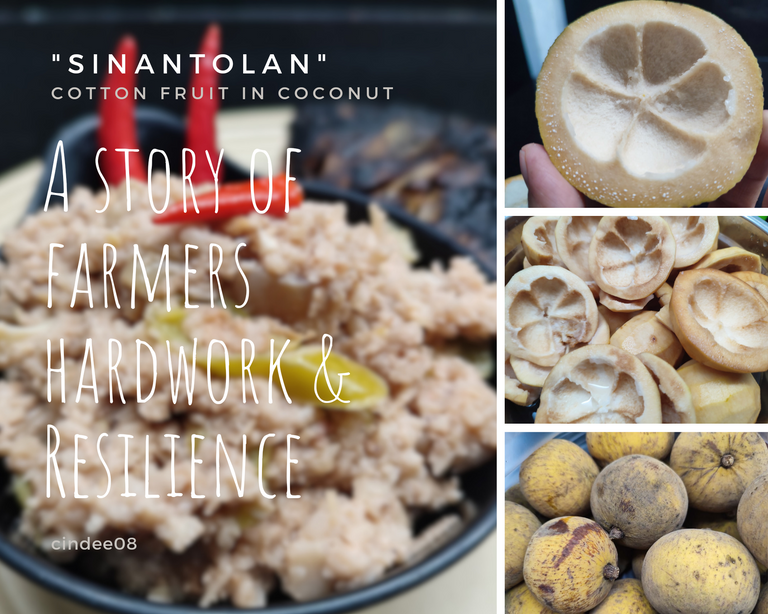
Cotton fruits, which are generally referred to as "santol" in the Philippines, are once again in season for harvest at this time of year. Because santol fruit surrounded our ancestral home, where I spent my formative years with my grandparents, I could remember quite clearly how our elders tried so hard not to waste a harvest. During this season, the abundance of santol and watching the ripe fruits fall to the ground and perish because no one is buying due to oversupply hurt the farmers the most.
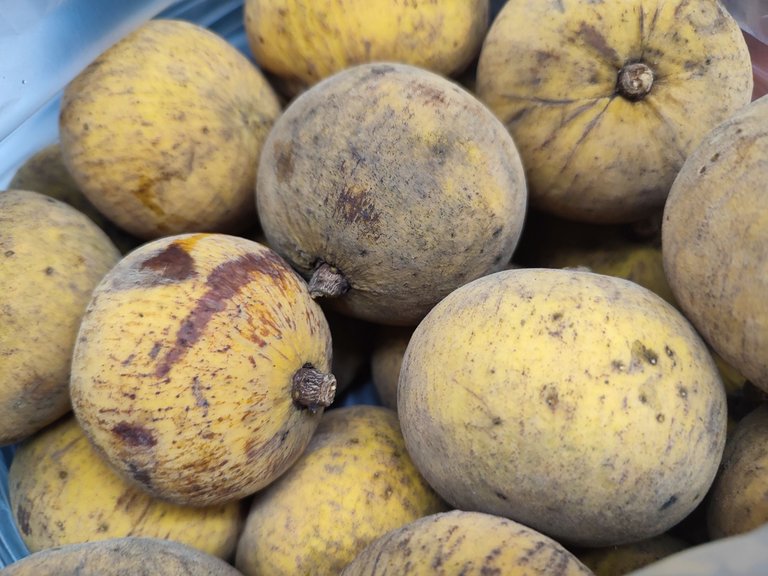
To a simple farmer who is just trying to make ends meet, every crop is a godsend, and farmers are striving to make the most of it so it won't go to waste, even if it requires more labor and a village to save a harvest. That's where jam and other fruit and vegetable preserves come into play. To maximize the use of the produce and extend the products' shelf lives and consumption windows.
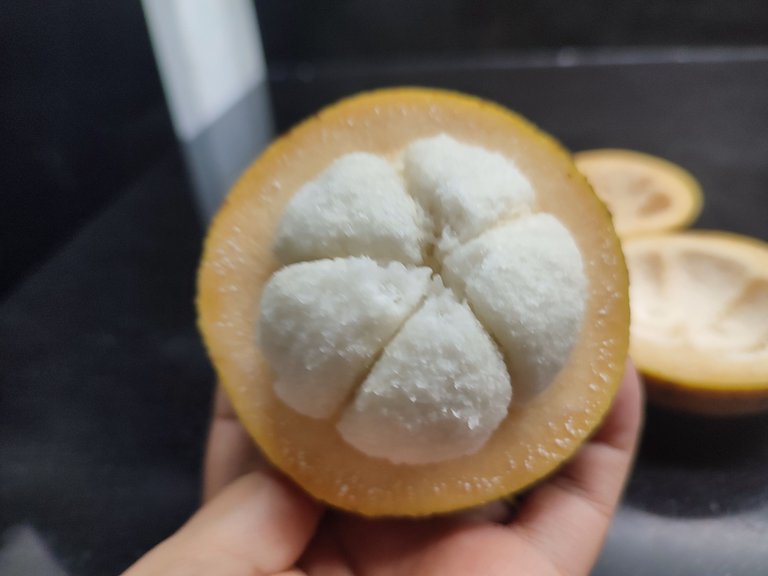 | 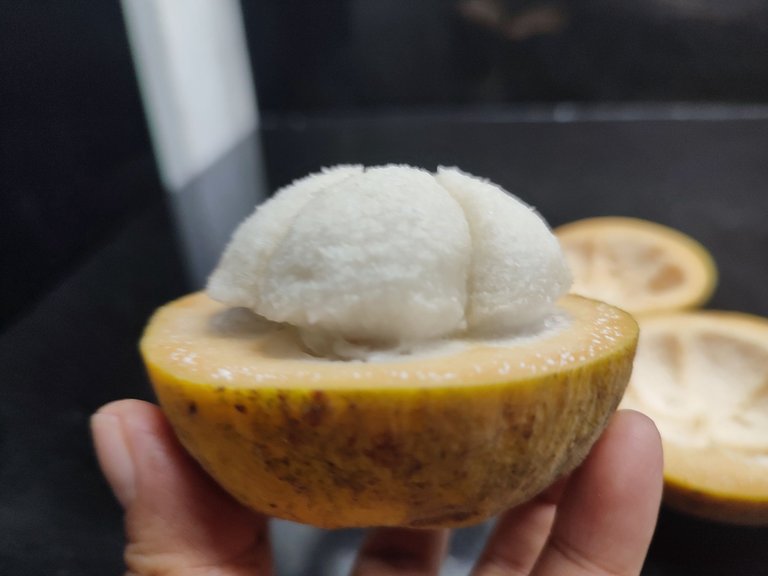 |
|---|
I remember waking up with a lot of sacks and baskets of ripe santol on our porch; some were given to family members and neighbors, but there was still a large amount left. At that point, my Tatay "grandfather" will bring out the kudkuran, a traditional coconut meat scraper that is also used for other fruits and vegetables, so we can begin scraping the cotton fruit's flesh in preparation for cooking and preserving it. Cotton fruit, or santol, can be converted into jam on occasion when we have the money to purchase sugar, but most of the time we make sinantolan because the essential ingredients are less expensive and readily available on the farm, including coconut, which is also common where we live.
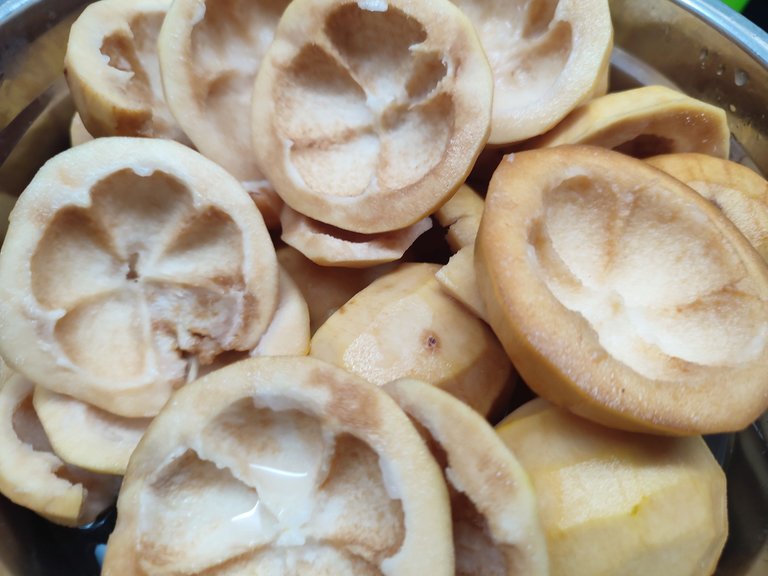
Scraping the pulp or flesh of cotton fruits takes a lot of time because it is smaller and softer than coconut, so you need to scrape it gently or else you will break it or scrape your hands instead. How much easier our lives would have been if we had had access to a food processor by that time! Me and my two other siblings are usually in charge of scraping the santol, and we take turns using the kudkuran. After scraping the santol, we will scrape the coconut and extract the milk that will be used for the dish next. We start at dawn, and the sinantolan will be ready before lunch.

In addition to the time-consuming preparation, cooking and simmering the sinantolan requires low heat until the coconut milk is reduced and the natural oil is rendered. The oil will help naturally preserve the dish for a longer shelf life.
This time, I will show you the modern process of making sinantolan. No more wooden kudkuran because I used a processor, but the cooking process and the recipe are still the same as what I learned from my grandfather.
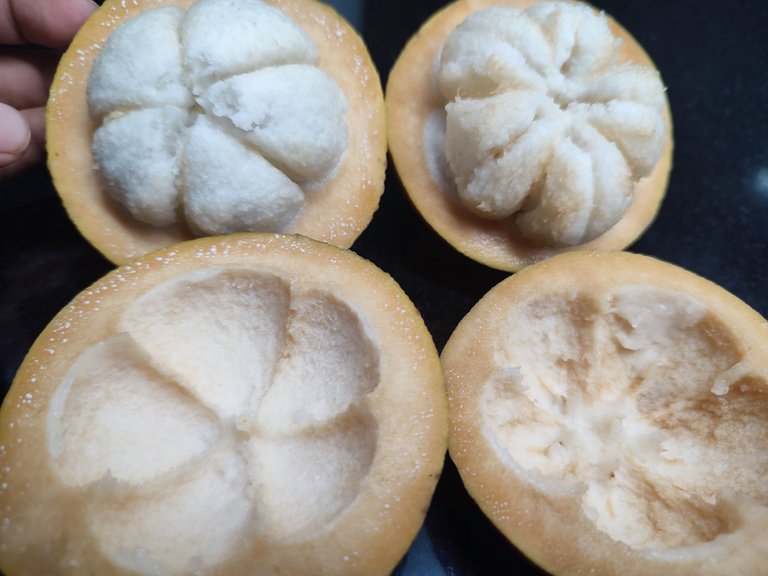
Traditionaly, we just cut the fruit in half, remove the seeds (don't forget to taste the cottony, sweet, and sour seed of the fruit; it's the most delicious, and the sweetest depends on variety), and then scrape the meat using kudkuran. But since I used a food processor, I peeled it first, cut it in half, and removed the seeds.

The peeled santol is submerged in water with salt to prevent it from darkening.
 |  |
|---|
After splitting it in half and removing the seeds, I put it in the processor batch by batch.
 | 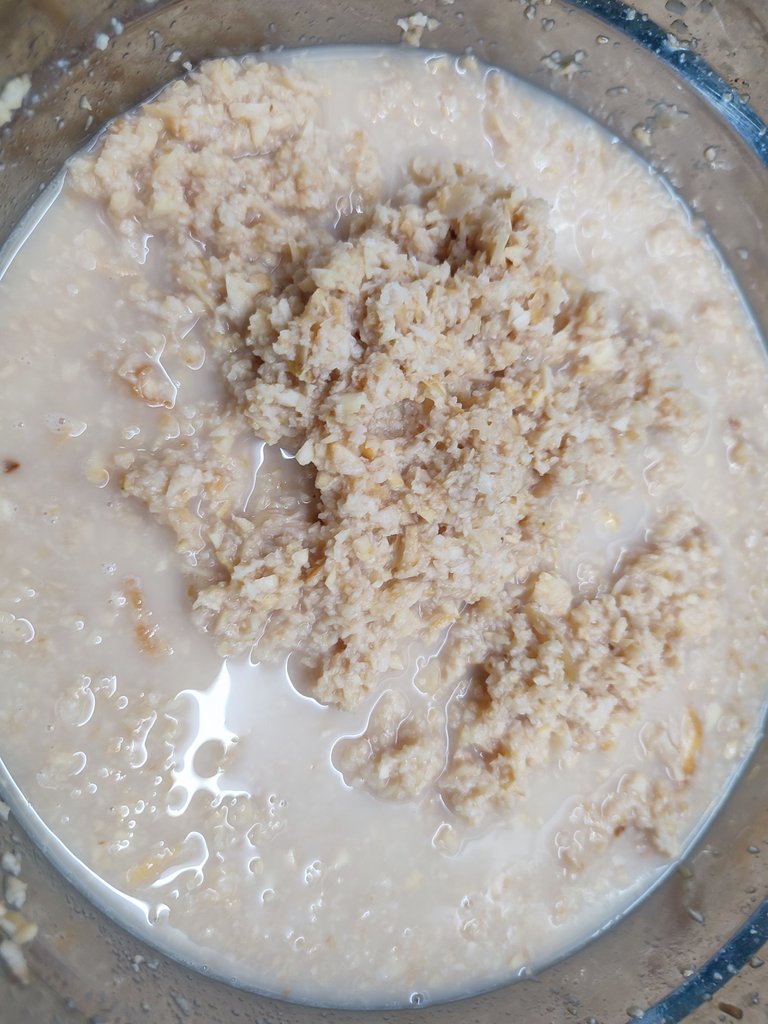 |
|---|
After mincing it in the processor, I put it back in the bowl of salted water to keep the color intact. It turned a reddish brown if not submerged in salty water, and I don't find the dish appealing with a dark color.
 |  |
|---|
The extraction of the juice and water comes last in the santol preparation process before cooking. This way, the sourness and tanginess of the fruit will be reduced, and extracting the liquid will give it more chance to absorb more coconut milk; thus, you will need a lot of coconut milk for this dish. For the juice extraction, I used a cheesecloth to squeeze and wring it.
Now we are done with the preparation of the cotton fruit. Let's get cooking!

Ingredients:
- 3 cups santol (peeled, seeded, grated and extracted)
- 1/4 kg pork belly (cubes)
- 4 cups coconut cream (kakang gata or pure)
- 6 cups coconut milk (pangalawang gata)
- 3 tbsp shrimp paste
- 1 medium red onion minced
- 5 cloves of garlic minced
- 5 pcs long green pepper
- 5 pcs Thai red chili
- 2 tbsp cooking oil
- salt
- pepper
Procedure:
- In a big pan, simmer the pork with salt and pepper until all the liquid evaporates, the pork turns light brown, and the fat starts rendering.
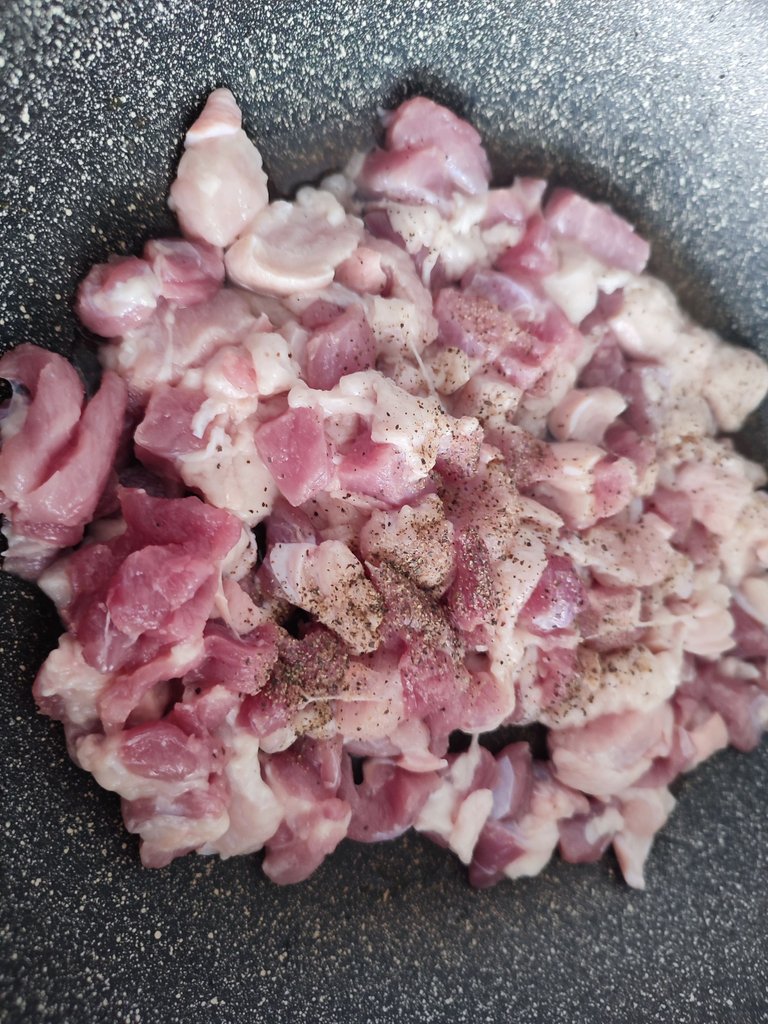 | 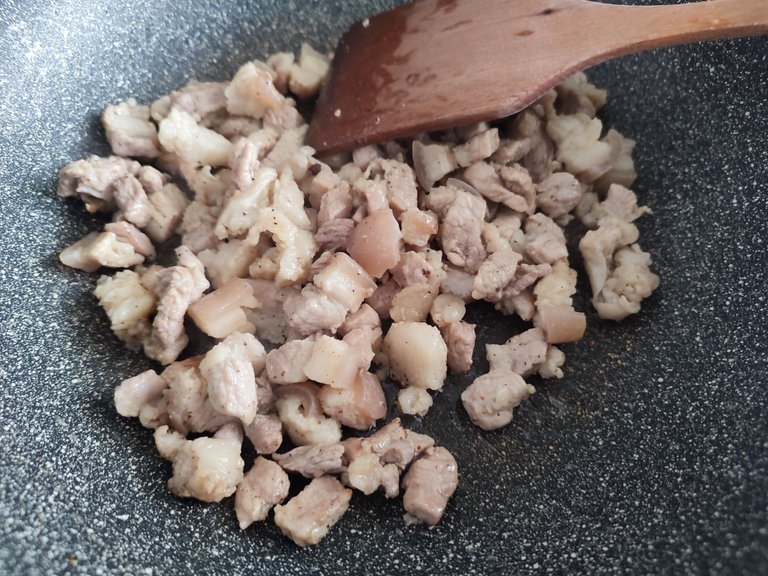 |  |
|---|
- In the same pan, set the meat on the side of the pan, add the oil, and sauté the garlic and onion until they become translucent and fragrant.
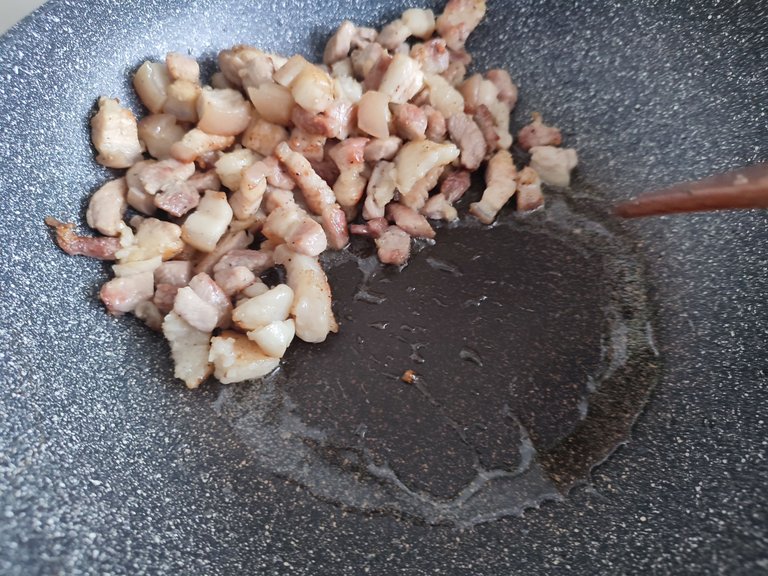 | 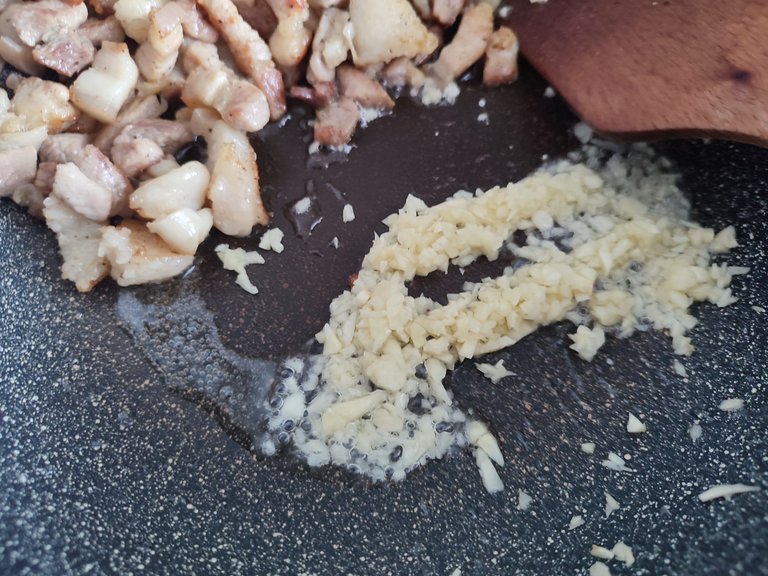 |  |
|---|
- Add the shrimp paste, mix until the flavors are encoporated, and then add the coconut milk. Let it simmer, mixing so often to keep the milk from curdling.
 | 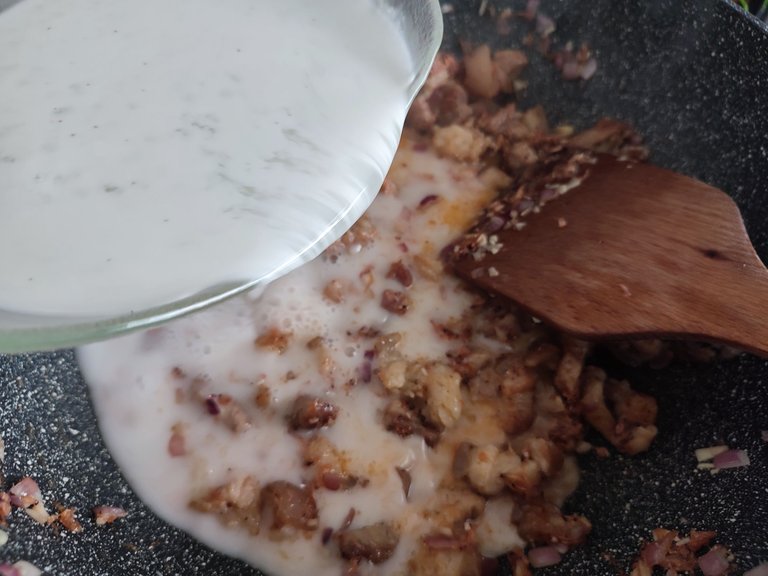 | 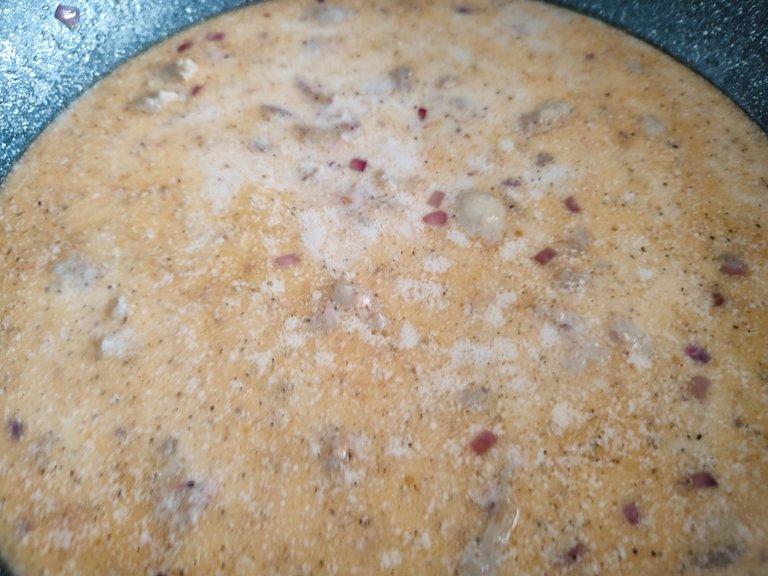 |
|---|
 | 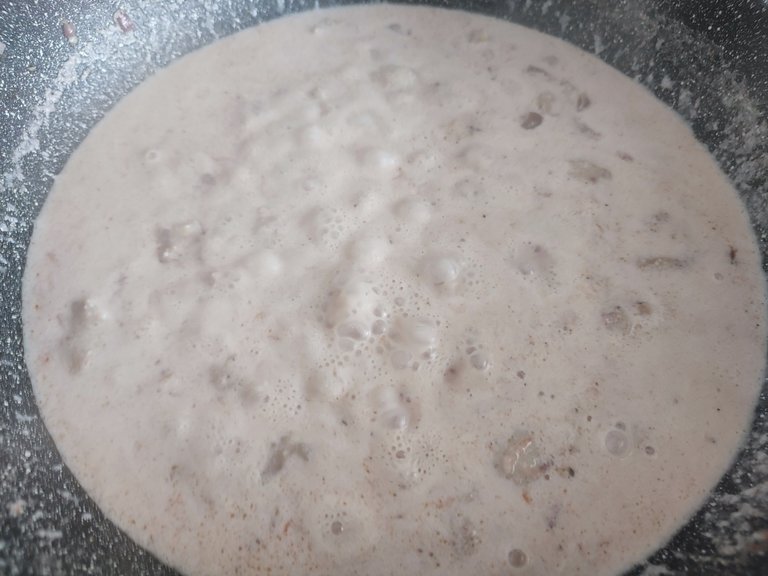 |
|---|
- Add the grated cotton fruit meat to the simmering coconut milk mixture.
 | 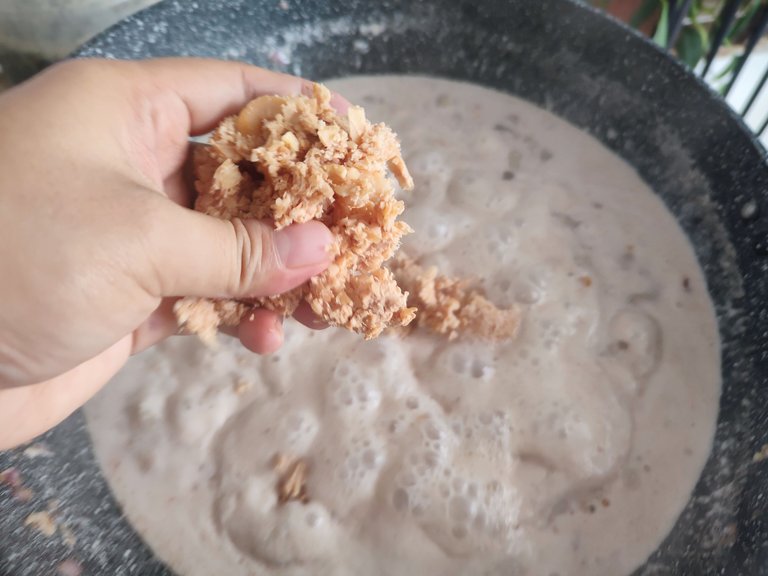 | 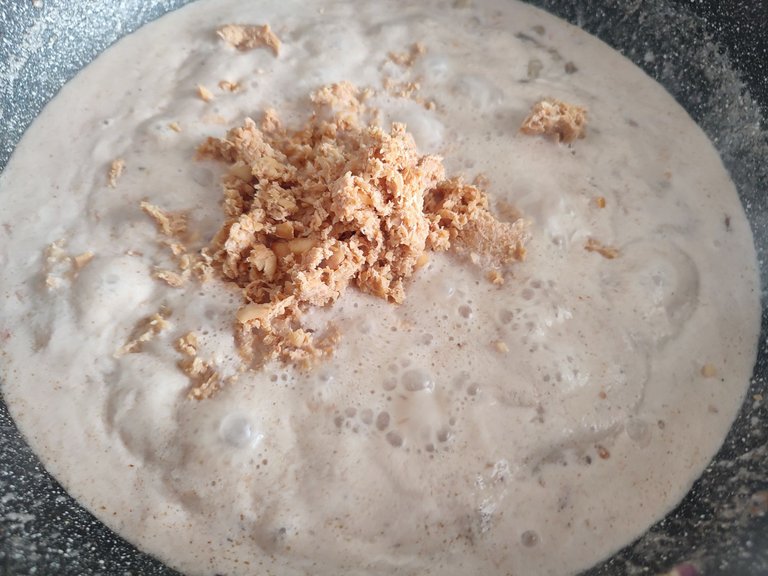 |
|---|
- Add salt and pepper to taste. Simmer until the liquid is reduced.
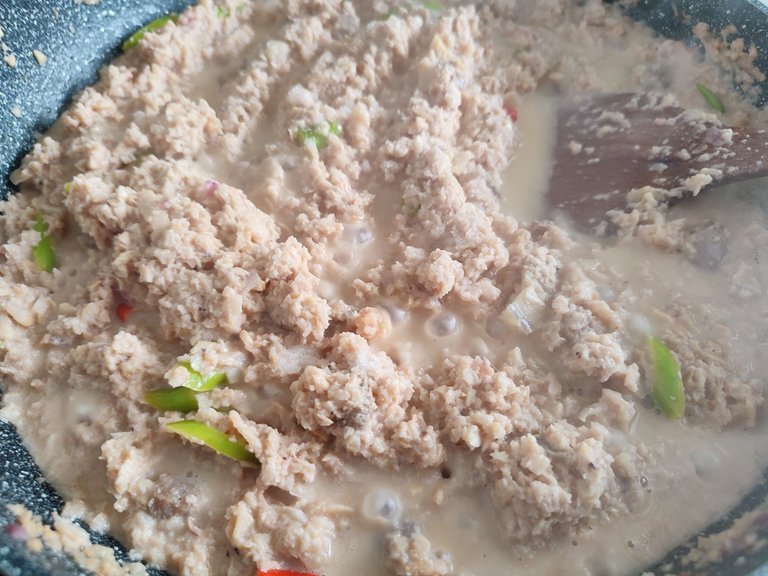 |  | 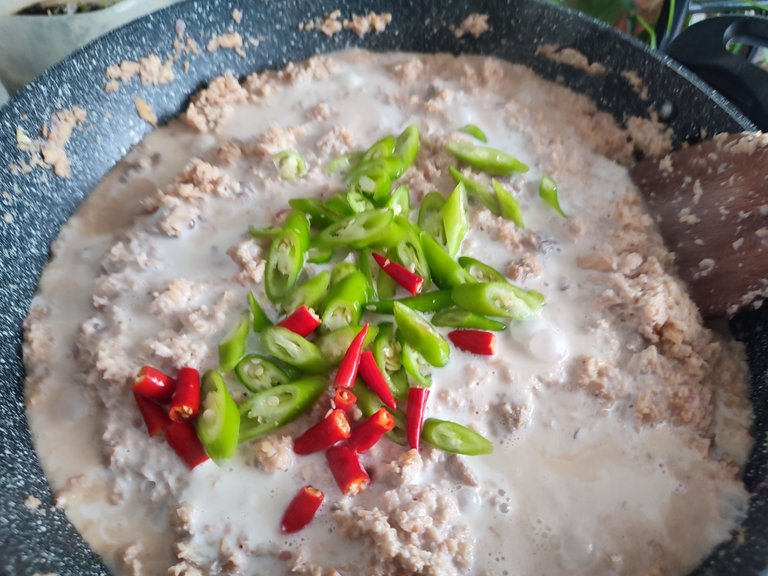 |
|---|
- Add the pure coconut cream to make the dish thick and creamy, and lastly, the red and green chilies.
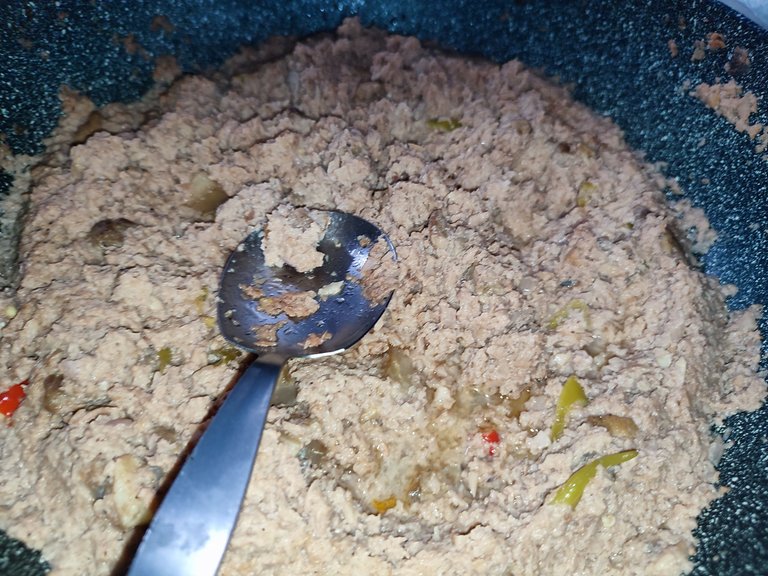
Set the heat on low and let the dish simmer until the coconut renders its natural oil. This way, it will make sure the dish is cooked all the way through, and the coconut oil will serve as a preservative to prolong shelf life.
Let it cool and transfer it to an airtight container.
Served with steamed rice. It is also best paired with fried, roasted, or grilled meat.
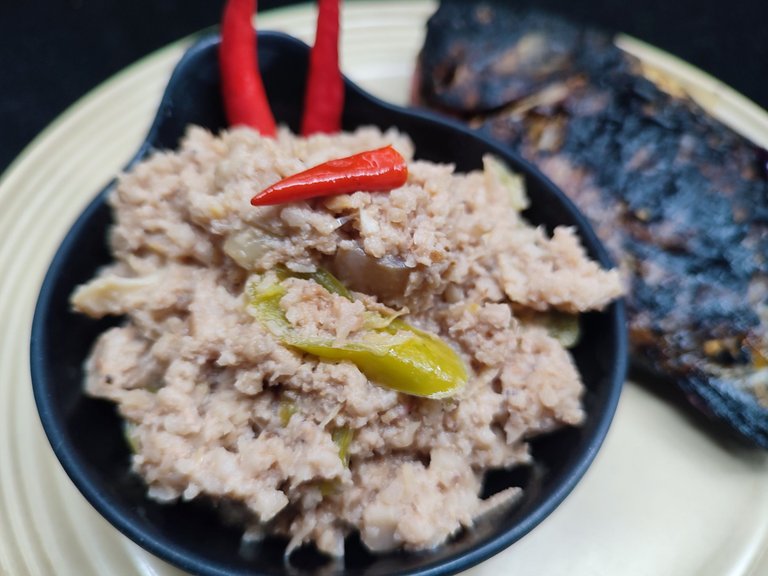 |  | 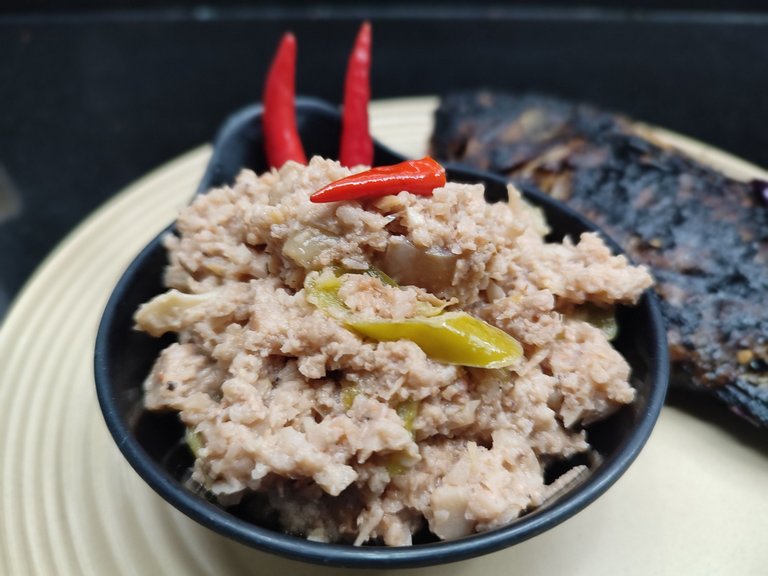 |
|---|
Normally, we place it in a sealed, sterilized recycled glass jar. My grandfather will proudly brag that it is our own harvest and that their nieces and nephews helped make it when he sends a few jars to his daughters, our aunts, who were working in a different town then.

There was also an instance where I brought a jar to my teacher as a present, and she ended up recommending it to her co-teachers, who then ordered some, and I ended up selling 14 orders at school. My grandfather was so happy when I got home. I think it was one of the moments that I remember him being proud of me.😆 Imagine that instead of wasting produce because of oversupply, we still made money out of it. As a reward, he gave me 10 pesos or like .18 $ and it was already a big amount for me then; I can buy a lot of sweet candies.😆
This dish brings me nothing but fondness and sweet memories; posting it on the blockchain will ensure that my kids and the generation after them can still read it and It makes my heart even fuller.
If you are from a family of farmers, how do you face or solve an abundant harvest or oversupply? Do you have a preserved or jam recipe that the world is unaware of? I will be happy to read about it!
Thank you for reading until the end, and see you on my next blog!
❤️❤️❤️

The lead image was edited using Canva.
All photos are my own, unless stated otherwise.
wow! Santol! When I was an elementary student, I used to buy santol fruit outside our school. It costs 3-5 pesos each, depending on the size of the one round santol fruit. I really like buying fruits that can be dipped in salt and red vinegar before going home. But now, I couldn't find some people selling santol fruit here.
Sana matikman ko din ang niluluto mo ate cindee! The sinantolan looks delicious kasi~ haha
ang mahal naman ng santol sainyo, piso lang samin e, pero di pa balat un hahahha masarap sya na may konting asim, di ka pa nakatikim nyan?
sana all daming santol
noon yun, nakailang bagyo na at nagkaputol putol na sila, tatlong puno na lang ata yung natira dun pero madami padin sila mamunga hahaha
Ganyan pala pagluto
matrabaho lang po sya ate heheh pero masarap po😊 !PIZZA
My aunt from Bicol once cooked like this..Ginataan lovers will surely love it.
Gata is life talaga sis sa bicol hahahah thanks for dropping by!
Oo nga eh..pag nag invite sa bahay nila yun, sigurado my ginataang santol.
Woooi sinantolan T_T Mindblown ako nung una kong try niyan!
uulit ka pa ba? hahahah weird sya sa iba pati yung itsura 😆 mga cousins ko laking manila di nila bet hahahah
oo! luv gata huhu baka naweirdohan lang sila kasi di sila sanay!
baka nga hahahaha kadiri daw e hahaha
Originally you mentioned making jam and the sweetness of the fruit so I thought this would be a sweet dish, then I saw the pork belly and fish paste in your recipe.
It sounds like a very tasty paste full of aroma, and certainly very versatile as well. Your grandfather is so resourceful!
Oh, sorry if it was a bit confusing; it was actually a side dish preserved, more like a pickle since it has the natural sourness of the cotton fruit.
Indeed, he was so resourceful that he also taught us how to make candy out of sweet potatoes and taros, but it had been decades since I last made it.
Thank you so much for reading! Much appreciated!❤️
$PIZZA slices delivered:
cindee08 tipped olivia08
@cindee08(1/5) tipped @scion02b
chichi18 tipped cindee08
Wow, I never thought cooton fruit can be eaten as a viand. I am impressed with your recipe.
thanks alot! di nga sya familiar sa ibang region, bicol at laguna lang ata nagluluto ng ganyan kasi may officemates ako taga Bacolod at Palawan ayaw nila itry nung una, pero nung nakatikim na lagi na nagrerequest magdala ako sa office hahaha
Nakakamiss ang santok, lalo yung tamis asim na lasa, mas naeenhance nga lang ang tamit woth a pinch of salt. Kakamiss ah, tagal ko na di na nakakain nare. And the totoo lang dipa ako nakakakain ng dish na nilalahukan ng santol. Curious na tuloy is me.
uy try mo na, alam ko may nabibili na nyan sa jar sa supermarket, not sure lang if it tastes otentik hahahha
Meron dito naga tinda. Maka bili nva ng isa at ng ma try minsan hahaha. Hanep sa otentik ampt, lol
lol, masarap talaga pag otentik ang lasa hahahahah
daming santol! naglaway ako bigla sis. hehehe
season nya sis! kaya ang mura din nya ngayon hehehe
seswa @cindee08 we have loads of Santol here atm and it is just nabubulok. I might wanna try this recipe kaso lagi ako nasa kalsada e. So how? LOL
I do love eating sinantolan. Pengeeeeeeeeeeee!
!PIZZA
ifood processor mo na yan kaysa mabulok, madala mo pa pabalik brunei hahahah
nakakatamad.yan talaga ang tunay. 😂
ay wala nang gamot yan hahahah
😂
oh I forgot to !pizza back hahahaha
Ho my tulo laway ko Sis @cindee08 while reading and felt the chillie taste, too. This is one rare dish the only like you experienced can cook this yummy
thanks ate, bata pa lang kasi ako nagkukudkud na ako nyang santol hahaha grade 4 ata ako nagbebenta na ako ng sinatolan sa mga teachers ko hahaha
I just found out that this fruit can be cooked with meat, in my area this fruit is also available.
It's just that now it's starting to not be found much anymore. Usually in our area eat it directly or make candied fruit
There's another version of it where instead of meat, they used just shrimp paste or boneless and shredded smoked fish, or what we locally call tinapa. The fruit is very versatile, actually. I tried it with fish and vinegar, or "paksiw" and it's also good, but this one with chili and coconut is so far my favorite.
Thank you for reading, dear! See you around!😊
Srrrp...looks good and yummy but my teeth are grinding from the "santol"
hindi na po sya maasim at mangilo sa ngipin ate kasi na extract na po yung juice nya hehehe
Thank you so much for reading!🙏❤️
https://leofinance.io/threads/wittyzell/re-leothreads-iw8vj3zm
The rewards earned on this comment will go directly to the people ( wittyzell ) sharing the post on LeoThreads,LikeTu,dBuzz.
First time to eat this was during a trip to Calaguas islands. It was awesome! I don't see this being sold in normal Filipino carinderias/restaurants much like Laing or Ginataang something.
My main way eating a santol though is still by dipping it through suka (i.e. sukang iloko), where the seeds get soaked in the vinegar and you get to suck it dry. Sarap!
ay may nakita ako sinantolan naka jar na sya kasama ng mga barrio fiesta na bagoong alamang, di ko pa natry so not sure kung same ang lasa hehehe but yeah bihira sya sa mga karinderya kasi matrabaho din kasi gawin. Thanks for dropping by! !PIZZA
It's my first time seeing one! I didn't know we can cook santol, I only tried eating santol with salt and bagoong.
Naging business real quick ang gift kay teacher! Iba ka yata mang sales talk ate Cindee! hahahaha
bata pa lang ako kung anu anu na binibenta ko sa school, wala kasi kami baon pera, food lang so para-paraan tayo hahahahha Thanks C!
Yay! 🤗
Your content has been boosted with Ecency Points, by @ruffatotmeee.
Use Ecency daily to boost your growth on platform!
Support Ecency
Vote for new Proposal
Delegate HP and earn more
Wuy! Thank you so much rooopa! @ruffatotmeee
Looks yummy but it entails some work to prepare the dish. Tiyaga mo naman, good job.
thank you so much po! Time consuming po pero masarap naman, I still have 4 jars in the fridge hehehe
Ay ngayon ko lng nabasa, sana Naman penge sinantolan 🥹